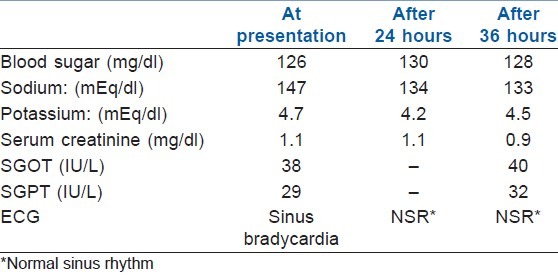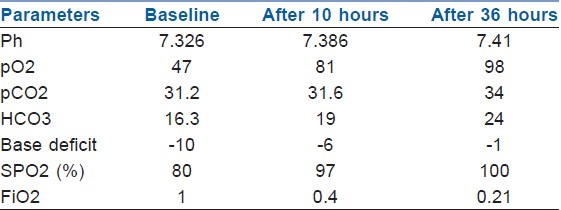Abstract
Peppermint oil is easily available as a constituent of medicines. A near fatal case due to ingestion of toxic dose of oral peppermint oil is being reported. The patient came in a comatosed state and was in shock. She was managed with mechanical ventilation and ionotropes. Her vital parameters reached normal within 8 hours and became conscious by 24 hours. The side effects of peppermint oil are considered to be mild but this case report warns that ingestion of oral toxic doses of peppermint oil could be dangerous.
Keywords: Menthol, peppermint, pulegone, toxicity
INTRODUCTION
Peppermint oil (PPMT) (Mentha piperita) is easily available organic oil. M. piperita is a hybrid of spearmint (Mentha spicata) and water mint (Mentha aquatica).[1] It is obtained from the stem, leaves and flower of the plant. The active constituents are menthol, menthone, cineol, pulegone and several other volatile oils.[2] It is commonly recommended for a variety of ailments like common cold, irritable bowel syndrome, non-ulcer dyspepsia, headache,[3] etc. It is also used as a flavoring agent in many products. Its side effects are claimed to be usually mild and minimally toxic (gastro esophageal reflux, heartburns, nausea, vomiting, allergic reactions and diarrhea). High doses could be hepatotoxic[2] and nephrotoxic (rarely interstitial nephritis and acute renal failure).[3] Herbal medicines like menthol oil (constituent of PPMT oil) are increasingly acknowledged due to the ever increasing use of herbal remedies amongst general population in developed and developing countries worldwide. We describe for the first time a near fatal case of poisoning due to oral peppermint ingestion.
CASE REPORT
A 40 year old female who was brought to the emergency room was suspected to have ingested PPMT oil. A strong smell of mint was emanating from her body. The exact amount ingested could not be ascertained. Clincal examination revealed that the patient was comatosed, had a heart rate of 60/minute, blood pressure not recordable, respiratory rate of 6-8/ minute, oxygen saturation of 30%. Her peripheral pusles were absent and extremities were cold and clammy. Auscultation of chest and precordium revealed normal vesicular breath sounds and normal heart sounds. Patient was immediately intubated without any resistance. Mechanical ventilation (SIMV mode) was instituted (FiO2-1). Gastric lavage was done with warm normal saline. Rapid intravenous infusion of crystalloid was started but her blood pressure did not improve. Thus, intra-venous infusion of dopamine was started, which was gradually increased to 10 μg/kg/min. In the mean time all her clothes were changed and wet sponging was done. Warming blanket and radiant warmer were applied. A 7.0 Fr triple lumen central venous catheter was inserted through right subclavian vein. Her urinary bladder was catheterized. The medication administered include inj ranitidine intravenous (iv), inj ceftriaxone iv, inj gentamycin iv, inj metoclopramide iv and antacid through naso-gastric tube. Since chest skiagram showed no evidence of aspiration and considering the possibility of peppermint oil ingestion causing nephrotoxicity, further dose of gentamycin was stopped. Her vital parameters [Table 1], blood investigation reports [Table 2] and arterial blood gas analysis [Table 3] is given below.
Table 1.
Vital parameters at different time intervals

Table 2.
Blood investigation reports

Table 3.
Arterial blood gas analysis

Dopamine infusion was gradually tapered and finally stopped after 8 hours. She started responding to physical stimuli (light glabellar tap) after eight hours and to her name at 24 hours. She was weaned from ventilator after 24 hours. Finally, after 36 hours, patient was conscious, maintaining vitals without support. Chest and cardiovascular examination was unremarkable. Her room air saturation was 100%. She was discharged from intensive care unit.
DISCUSSION
We present a near fatal case of toxic dose of oral PPMT oil ingestion. We received the patient in comatosed state probably because of hypoxemia or because of direct toxic effect of PPMT oil on brain. PPMT oil has over 30 known components.[2] It is comprised mainly of menthol (35-60%) and menthone (15% to 30%), but also contains pulegone, a known neurotoxic agent.[1] Rats treated with pugelone developed dose dependent atonia. Although it is stipulated that in cosmetic formulations the concentration of pugelone be kept 1% or lower but it was found in the range of 1% to 4%.[2] Since, the patient described here presumably consumed a large amount of PPMT oil in a suicidal bid, it is possible that the absolute amount of pugelone became significant leading to severe atonia which in turn led to hypoxia.
In contrast to intra-venous abuse of PPMT oil,[4] oral toxic dose of PPMT oil did not apparently cause lung injury. In the present case, mechanical ventilation was instituted for diminished respiratory drive, probably because of its central effect and not for acute lung injury. In addition to the pulegone induced atonia, toxic oral dose of PPMT oil may have also central effects which might have caused hypoxemia as evidenced by bradypnea leading to cardiorespiratory compromise. In the state (shock like) in which the patient presented to us cannot be explained by peripheral vasodilatation because peppermint oil has been known to cause vasoconstriction[1] . Thus, shock like state of the patient may be due to central effects of PPMT oil.
Peppermint oil had been previously reported to be hepatotoxic[1,5] and nephrotoxic[3]. Hepatotoxicity is attributed to the presence of pulegone, which is a recognized hepatotoxin[1] . It is found in young peppermint leaves and is later metabolized to menthol. There is a residual concentration of 1-4% of pulegone in peppermint oil. In our patient there was no evidence of nephrotoxicity (normal serum creatinine and absence of dyselectrolytemia) or hepatotoxicity (normal SGOT and SGPT).
Allergic reactions to menthol is well known.[1,6] But our patient did not have any obvious signs of allergy like swelling, wheals or erythema anywhere on the body. More importantly, there was no swelling, erythema of the lips or face. Also the comatosed state of the patient did not improve even after the blood pressure was normalized at 2-4 hours. It took more than 8 hours for the patient to respond to light glabellar tap. This suggests that patient's state was more likely to central action of PPMT oil and less to allergic reaction of the same.
The lethal dose of PPMT oil had been documented in experimental studies. It had a 24 hour oral LD 50 of 4441 mg/kg in fasted Wistar rats whereas the 48 hour LD 50 was 2426 mg/kg.[7] Unfortunately the precise amount of PPMT oil ingested could not be ascertained in the case described here. In management of overdose of peppermint oil ingestion, role of activated charcoal has also been described[8] and it can also be tried.
Most of the literature on PPMT oil note the side- effects of PPMT oil ingestion as mild.[1,2] Side effects were described as minimally toxic,[4] whereas this case report shows that the side-effects could be dangerous and potentially fatal.
The lessons that the medical fraternity needs to learn from this unfortunate case of suicidal bid by consuming toxic dose of PPMT oil are: firstly, that there is no specific antidote to PPMT oil. Secondly, ingestion of toxic doses of PPMT oil can be dangerous and life threatening, and this warning should be included on all products containing PPMT oil. Thirdly, treatment of PPMT oil poisoning is mostly supportive, which might include mechanical ventilation and use of ionotropes. Finally, one of the constituents of PPMT oil is pugelone, which is a neurotoxin, but further animal studies are warranted to know if it is capable of producing all the symptoms that the patient described here exhibited.
Footnotes
Source of Support: Nil
Conflict of Interest: None declared
REFERENCES
- 1.Herro E, Jacob SE. Mentha piperita (peppermint) Dermatitis. 2010;21:327–9. [PubMed] [Google Scholar]
- 2.Nair B. Final report on the safety assessment of Mentha Piperita (Peppermint) Oil, Mentha Piperita (Peppermint) Leaf Extract, Mentha Piperita (Peppermint) Leaf, and Mentha Piperita (Peppermint) Leaf Water. Int J Toxicol. 2003;20(Suppl3):61–73. [PubMed] [Google Scholar]
- 3.Kligler B, Chaudhary S. Peppermint oil. Am Fam Physician. 2007;75:1027–30. [PubMed] [Google Scholar]
- 4.Behrends M, Beiderlinden M, Peters J. Acute lung injury after peppermint oil ingestion. Anesth Analg. 2005;101:1160–2. doi: 10.1213/01.ANE.0000175774.33435.87. [DOI] [PubMed] [Google Scholar]
- 5.Akdogan M, Ozguner M, Aydin G, Gokalp O. Investigation of biochemical and histopathological effects of Peppermint piperita Labiatae and Peppermint spicata labiatae on liver tissue in rats. Hum Exp Toxicol. 2004;23:21–8. doi: 10.1191/0960327104ht412oa. [DOI] [PubMed] [Google Scholar]
- 6.Tran A, Pratt M, DeKoven J. Acute allergic contact dermatitis of the lips from peppermint oil in a lip balm. Dermatitis. 2010;21:111–5. [PubMed] [Google Scholar]
- 7.Eickolt TH, Box RH. Toxicities of peppermint and Pycnanthemun albescens oils, fam Labiateae. J Pharm Sci. 1965;54:1071–2. doi: 10.1002/jps.2600540732. [DOI] [PubMed] [Google Scholar]
- 8.Maypole J, Woolf AD, Donovan JW. Essential oils. In: Shannon MW, Borron SW, Burns MJ, editors. Haddad and Winchester's Clinical Management of Poisoning and Drug Overdose. 4th ed. chap 101. Philadelphia, Pa: Saunders Elsevier; 2007. [Google Scholar]


